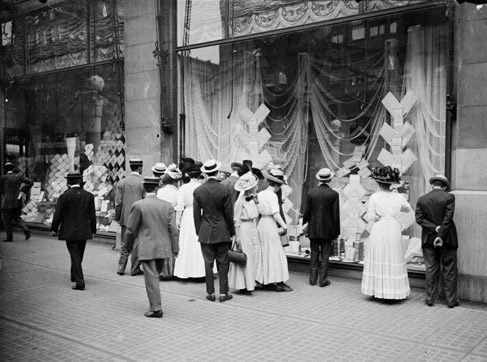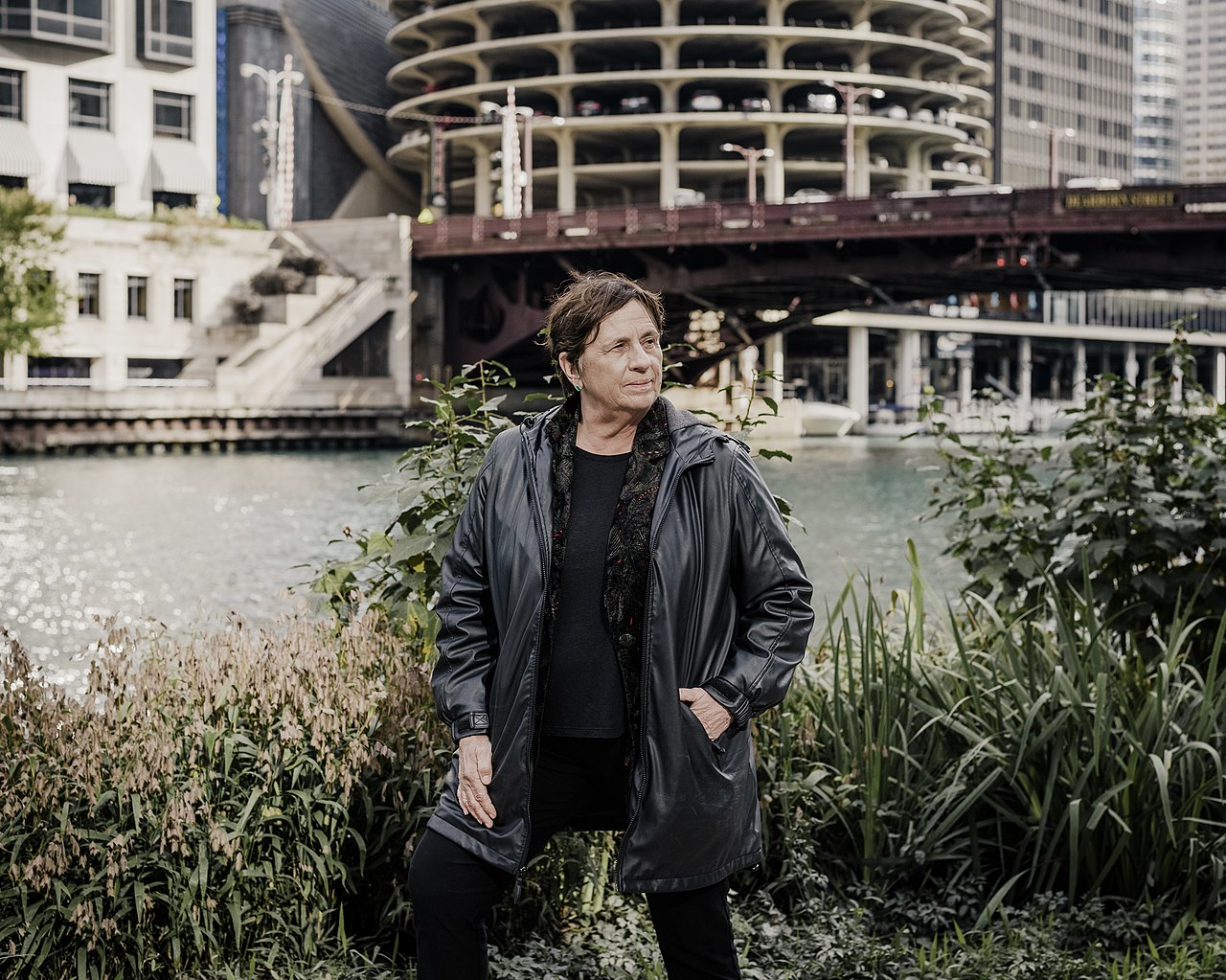Black Friday in Chicago always brings hordes of deal-seekers to the downtown State Street shopping district. The term Black Friday arose in the 1980s, but State Street, that “great street,” has been a shopping mecca since the days of the great department stores. What about the stores of holidays past, the ones that are no longer around?
Starting it all, Field, Leiter, and Co., the predecessor of the legendary Marshall Field’s, moved into its “marble palace” store at State and Washington in 1868. In the century and a half since then, scores of grand department stores and retailers have occupied huge chunks of real estate along the mile of State Street within the Loop. You can learn more about the holiday traditions at Field’s on a virtual tour with us.
Back in the day, department stories really had “bargain basements” and holiday windows didn’t appear until the day after Thanksgiving (long before it was called Black Friday). In honor of those shoppers’ paradises of the past, let’s take a look at the departed department stores of State Street.
We research stories from Chicago history, architecture and culture like this while developing our live virtual tours, in-person private tours, and custom content for corporate events. You can join us to experience Chicago’s stories in-person or online. We can also create custom tours and original content about this Chicago topic and countless others.
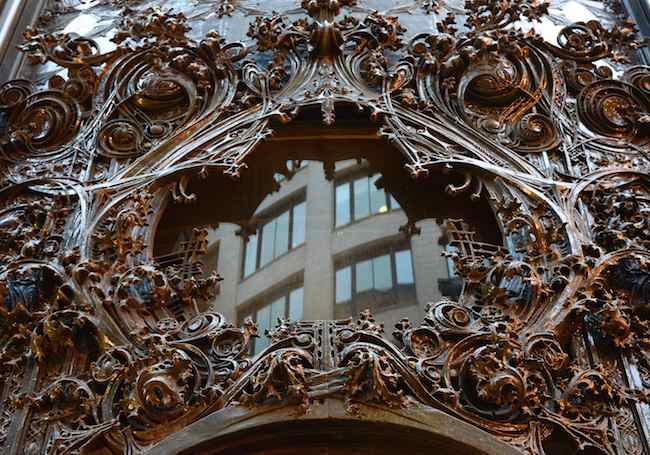
Carson, Pirie, Scott, and Co.
I’ll start with one of the most recent departures. Carson, Pirie, Scott, and Co. (Carson’s for short) was a retail mainstay at State and Madison from 1881 to 2007. For most of that time it occupied the eponymous building designed by Louis Sullivan in 1899. We have the pleasure of visiting the store during many of our Downtown Bucket List private tours.
The structure is a masterpiece of the Chicago School of architecture and was one of Sullivan’s last major works. Its steel-frame construction allowed massive windows to illuminate the store and show off goods in the store windows. Perhaps most famously, the finely-wrought iron work in its marquee and facade are stunning examples of “Sullivan-esqe” decor.
Carson’s closed up shop in 2007 and the building was renamed “The Sullivan Center” in honor of its architect. Today, the upper floors are used as office and classroom space for tenants like the School of the Art Institute of Chicago. The bottom floors were converted into a flagship store for Target. Thankfully, they have carefully restored and honored Sullivan’s original work in their new store on State Street.
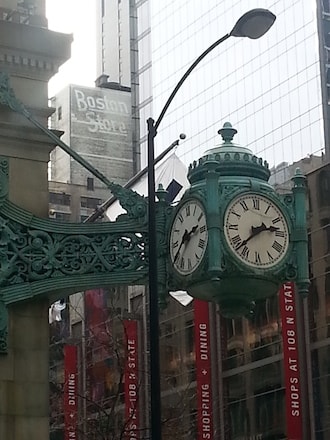
The Boston Store
Don’t be fooled by the ghost sign that floats a dozen stories above State Street and Madison. The Boston Store has not been in operation in Chicago since 1948. Yet that sign indicates the shopping paradise that once fronted “the busiest corner on earth” for 75 years.
The Boston Store was the product of is initial manager, Charles Netcher, whose “career followed the traditional Horatio Alger pattern” according to the Chicago Tribune. He ran the store for 30 years, until his death in 1904.
The building constructed to house the Boston Store is a 17-story giant that runs the entire block along Madison from State to Dearborn. It housed a Walgreen’s from 1949 to 1999 and then became a flagship store for Sears. In 2014, Sears closed the State Street store and now it has reverted to a Walgreen’s location
Mandel Bros. and Wieboldt’s
The intersection of State and Madison hosted yet another major department store during State Street’s shopping heyday. The Mandel Bros. store dated all the way back to 1855, when it was founded by a quartet of brothers who emigrated to Chicago from Germany.
The original store was on Clark, but they migrated to State Street in 1912, at the urging of Marshall Field himself, after their previous stores burned down in the fires of 1871 and 1874. The Mandel Bros.’16-story flagship store went through the same boom and bust cycles as the rest of the retail industry through the first half of the 20th Century. Ultimately, it was suburbanization that doomed the store. As people moved out of Chicago to the burbs, they took their shopping with them. Despite the robust economy, their revenues fell nearly 20% during the 1950’s.
The company was bought out by the local Wieboldt’s chain, which previously had locations out in the neighborhoods but not on State Street. Wiebold’ts was known for its awesome toy department, which they called the “Toyteria.” For holiday shopping, they promoted their bow-tied Cinnamon Bear. The character appeared in radio shows, and subsequently also television shows. Cinnamon Bear traveled to imaginary places, like the root beer ocean or a land of candy pirates. Wieboldt’s remained in operation at 1 N. State St. until shuttering in 1987. The building is now home to offices and smaller shops like T.J. Maxx.
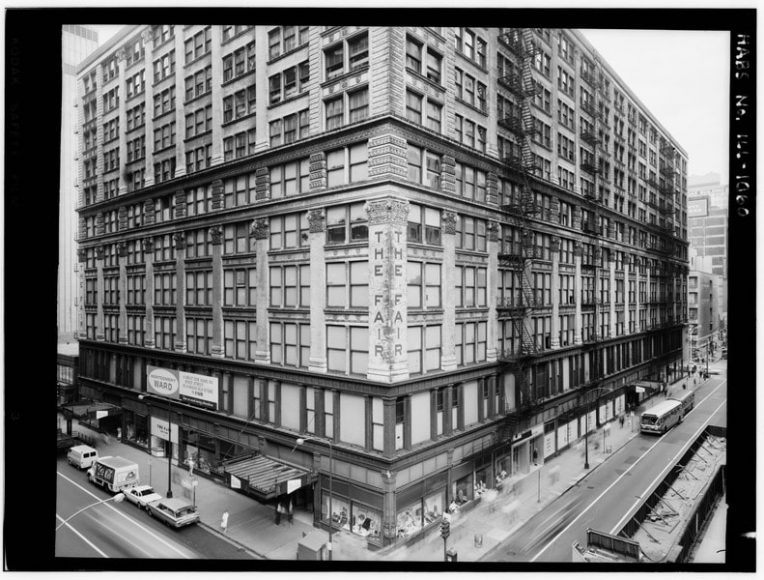
The Fair Store on State Street
A little further south on State Street, a Gilded Age shopper whose pocketbook wasn’t voluminous enough for Field’s might have headed to The Fair Store. The original owner, Ernst J. Lehmann, gave it the name because “the store was like a fair because it offered many different things for sale at a cheap price.” My guess is that he also wanted to ride the coattails of the massively popular world’s fairs, like the 1893 Columbian Exposition, which were so popular in that day.
The Fair Store specialized in lower-priced merchandise for shoppers who wanted merchandise that looked good without breaking the bank. It was like a sort of a turn-of-the-century Target, from what I gather. The massive structure was completed in 1897 and stood on the northwest corner of State and Adams and took up the entire half-block west towards Dearborn.
The Fair Store on State Street went through a rotation of stores. It was eventually controlled by the Kresge Corporation (aka Kmart), then Montgomery Ward’s, and it was torn down in the ’80s.

A. M. Rothschild & Co.
A block south of the Fair Store is a structure that began its life as the A. M. Rothschild & Co. Department Store in 1912. Spanning between Jackson and Van Buren on State Street, this building was home to the store only until 1923. Perhaps only be a handful of people are still alive who remember shopping there. Marshall Field’s bought it, and made it into a discount store “The Davis Store.”
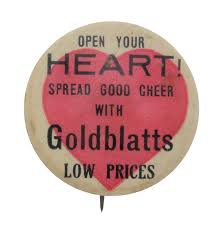
It was sold again to Goldblatt’s Department Store. Started by Polish immigrants, Goldblatt’s was another discount retailer. Goldblatt’s had many locations in Chicago neighborhoods. They stocked food products in the basement versus the bargains which were all over the store. It’s said that one could get Polish sausage or freshly roasted nuts. They were here on State Street until 1981.
Then the city looked into acquiring the property and making it into a new central library, since the library had vacated what is now the Chicago Cultural Center. Instead, they built the new Harold Washington Library kiddy-corner from the former Goldblatt’s location. The overall building was refurbished and DePaul University moved into it in 1993. You can still see the “R” initials for Rothschild on the exterior.
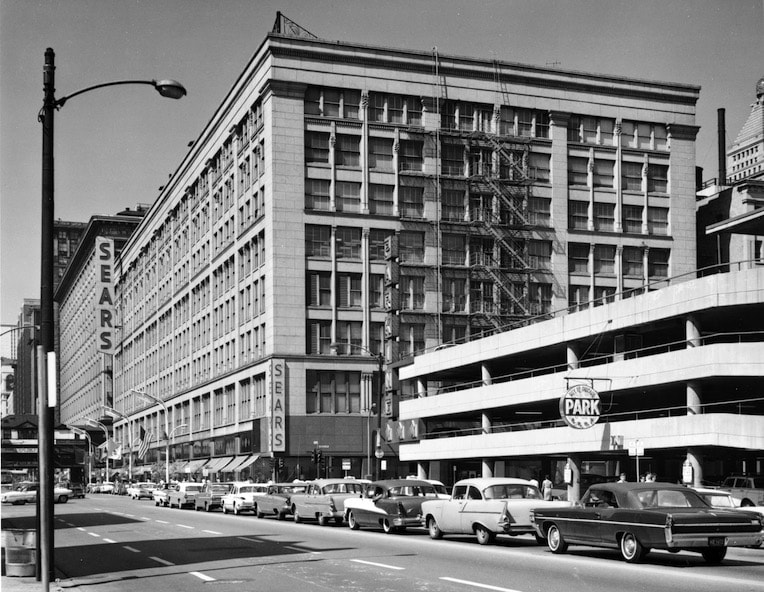
Siegel, Cooper & Co.
Siegel, Cooper & Co. was another gigantic discount department store near the southern end of State Street’s shopping district. Seems to me that the further you went from Marshall Field’s, the further the prices went down!
In 1891, the store moved into the Second Leiter Building, an early example of skeletal steel frame from the Chicago school of architecture. Not to geek out over Chicago architecture too much, but the engineering of Chicago school architecture created more floorspace and larger windows, which perfectly suited a large-scale retailer like Siegel, Cooper & Co.
The company was folded into a new retail amalgam named Associated Dry Goods by J.P. Morgan in 1914. That new holding company closed Siegel, Cooper & Co.’s State Street store in 1930. Sears moved into the building that same year, and is not there any longer (but of course Sears Corporation would deserve a blog post in itself). Today, it’s the campus of Robert Morris University.
Historic State Street Department Stores
Many department stores of State Street have come and gone through out Chicago history. The internet pervades our shopping habits today, but we can at least imagine at the days of bargain basements and holiday bear radio shows.
– Alex Bean and Amanda Scotese
ABOUT CHICAGO DETOURS
Chicago Detours is a boutique tour company passionate about connecting people to places and each other through the power of storytelling. We bring curious people to explore, learn and interact with Chicago’s history, architecture and culture through in-person private group tours, content production, and virtual tours.

